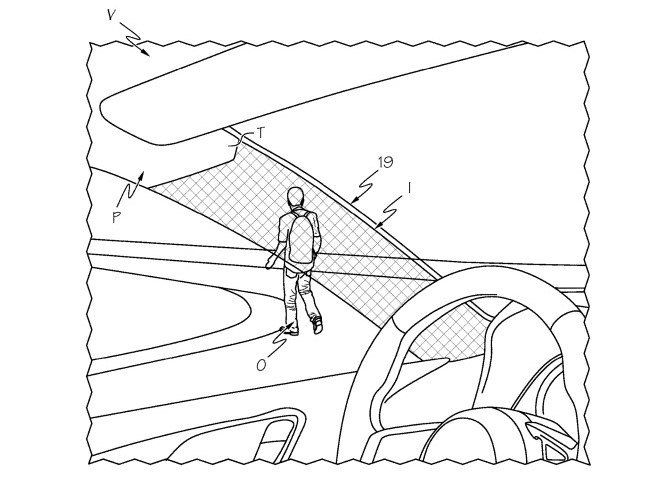Bulky A-pillars Getting in the Way? Toyota Has a Clear Solution

Back in the days of sky-high tailfins and wraparound windshields, A-pillars weren’t of sufficient thickness to hide little Timmy riding his bike, or maybe that Ford Fairlane approaching from behind that shrub to your left. No, front seat vision was grand — trying to stop your Detroit barge with unassisted drums brakes was the real challenge.
These days, the high-strength steel and airbags needed for rollover and side-impact protection have turned those slim pillars into Corinthian columns capable of hiding a small crowd. A-Pillars are bulky, and that’s a safety problem in itself.
What to do? In Toyota’s case, simply develop a way of seeing through them.
According to a patent application filed to the U.S. Patent and Trademark Office by Toyota’s American engineering arm, the automaker hopes to give drivers a way of seeing past those intrusive beams. No, Toyota isn’t patenting honeycomb pillars. (That apparently Genesis’ job.)
Toyota’s plan is to have light bend around the pillar, thus making it disappear from view. Freaky stuff, but not the time-bending pseudo-science of Philadelphia Experiment folklore. The “cloaking device” in the company’s patent uses a far simpler and cheaper solution: carefully arranged mirrors.
By reflecting what’s behind the A-pillar onto the interior surface of the pillar, the obstruction all but vanishes, leaving the driver looking at little Timmy or that errant Fairlane instead. Toyota explains it a far more technical, albeit confusing way:
A cloaking device includes cloaking region boundary planes oriented non-planar to each other, each of the cloaking region boundary plans having an outward facing mirror surface and an outward facing opaque surface. The cloaking device includes a cloaking region bounded at least partially by the inward facing opaque surfaces of the cloaking region boundary planes. Half mirrors are spaced apart and generally parallel to the outward facing mirror surfaces such that a half mirror is spaced apart and generally parallel to each outward facing mirror surface. Light from an object on an object-side of the cloaking device is directed around an article within the cloaking region and forms an image on an image-side of the cloaking device such the article appears transparent to an observer looking towards the object.
Got it?
The patent application describes the cloaking device as a cost-conscious alternative to pricey video display technology under development by other automakers. Presumably, the mirrored surfaces wouldn’t interfere with the pillar-mounted airbag.
Whether or not we’ll see these see-through pillars in a future Toyota or Lexus vehicle remains to be seen (or not, ha ha), so for now we’ll have to be content with the above drawing.
[Images: Toyota]

More by Steph Willems
Latest Car Reviews
Read moreLatest Product Reviews
Read moreRecent Comments
- Namesakeone If I were the parent of a teenage daughter, I would want her in an H1 Hummer. It would be big enough to protect her in a crash, too big for her to afford the fuel (and thus keep her home), big enough to intimidate her in a parallel-parking situation (and thus keep her home), and the transmission tunnel would prevent backseat sex.If I were the parent of a teenage son, I would want him to have, for his first wheeled transportation...a ride-on lawnmower. For obvious reasons.
- ToolGuy If I were a teen under the tutelage of one of the B&B, I think it would make perfect sense to jump straight into one of those "forever cars"... see then I could drive it forever and not have to worry about ever replacing it. This plan seems flawless, doesn't it?
- Rover Sig A short cab pickup truck, F150 or C/K-1500 or Ram, preferably a 6 cyl. These have no room for more than one or two passengers (USAA stats show biggest factor in teenage accidents is a vehicle full of kids) and no back seat (common sense tells you what back seats are used for). In a full-size pickup truck, the inevitable teenage accident is more survivable. Second choice would be an old full-size car, but these have all but disappeared from the used car lots. The "cute small car" is a death trap.
- W Conrad Sure every technology has some environmental impact, but those stuck in fossil fuel land are just not seeing the future of EV's makes sense. Rather than making EV's even better, these automakers are sticking with what they know. It will mean their end.
- Add Lightness A simple to fix, strong, 3 pedal car that has been tenderized on every corner.



































Comments
Join the conversation
Jaguar/Land Rover had one of these as a concept back in 2014 called "360 Virtual Urban Windscreen system". It used screens instead of mirrors, but it had the same result. I wonder if they patented it?
people still look out the windshield? every driver i see these days is staring at their phone